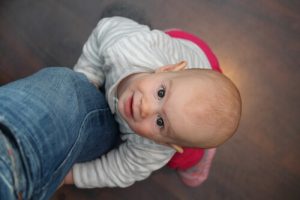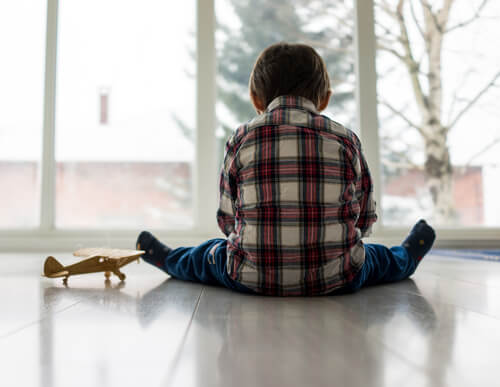Reactive Attachment Disorder: Causes and Treatment

Have you ever wondered how a child is affected by not receiving proper care from his parents? Have you heard about reactive attachment disorder? Keep reading to find out what it is and how it affects children.
Reactive attachment disorder is a reality that many people suffer. It derives from inadequate treatment in childhood on the part of one’s attachment figures, and it has devastating consequences in adulthood.
Knowing the symptoms a child presents and remedying them as soon as possible is fundamental for their recovery and their subsequent development into a balanced, confident and happy adult.
Reworking the concept of oneself, assuming that we deserve to be loved even if we did not receive that love from the people who owed it to us, is a difficult but restorative path.
What causes reactive attachment disorder?
Attachment is the emotional bond that unites a baby with a caregiver. Generally, the first caregivers are the parents, so the bond is usually formed with them.
The parents give affection, care, safety and protection to the baby, and based on these basic needs, a union is generated that will last a lifetime. As this attachment develops, it defines the child‘s development as an adult.

But, what happens when this link is toxic? We’re referring to when a baby, instead of receiving attention, receives abandonment, abuse or neglect. This is when reactive attachment disorder comes up.
The disorder develops not only with parents who don’t attend to their child’s physical or emotional needs, but also when a child’s primary caregiver changes too often.
How to discover reactive attachment disorder
When they’ve had no attachment model, children develop different methods to be safe in the world.
Thus, depending on the child, these can develop around two opposite poles:
- Inhibited type. Children who belong to this group tend to be withdrawn. They won’t enjoy the company of others and prefer to be alone. In addition, they’ll reject any kind of physical contact with others and even with the main attachment figure. They’ll experience episodes of irritability, sadness or fear without apparent cause. They’ll be unable to build trusting relationships, something that can accompany them throughout their lives.
- Uninhibited type. The children in this group will seek affection anywhere and with anyone. They won’t take the precaution of distinguishing between strangers and family, so they’ll approach any adult, in search of emotional support not received from their caregivers.
In addition, common symptoms include a lack of empathy and low tolerance for frustration.
These symptoms don’t belong exclusively to reactive attachment disorder, but they do identify it. For a more real and accurate diagnosis, it will be necessary to go to a professional.
It is never too late to have a happy childhood.
–Tom Robbins–
How to treat reactive attachment disorder
Once diagnosed, the treatment will be determined by the specialist. It is necessary to evaluate the degree to which the child is affected.
Therapy is usually effective. Depending on the person’s age, it will be more or less complicated to reconstruct this perception of attachment. In the case of young children, it is necessary to find an attachment figure that is emotionally available to the child.

When they become adults, it is very complicated to overcome, but not impossible. Focusing on a childhood of abandonment, abuse or total lack of care to get that moment resolved will undoubtedly be painful.
All the people who suffer from reactive attachment disorder share one thing in common: suffering. The fact of not having received the love, care and affection they deserve makes them afraid to face anything. In many cases, they aren’t aware of it, which is why the intervention of a professional is often crucial.
Reworking the concept of oneself, assuming that we deserve to be loved even if we did not receive that love from the people who owed it to us, is a difficult but restorative path.
All cited sources were thoroughly reviewed by our team to ensure their quality, reliability, currency, and validity. The bibliography of this article was considered reliable and of academic or scientific accuracy.
- Barudy, J., & Dantagnan, M. (2005). Los buenos tratos a la infancia: Parentalidad, apego y resiliencia. Editorial Gedisa.
- Galán Rodríguez, A. (2010). El apego: Más allá de un concepto inspirador. Revista de la Asociación Española de Neuropsiquiatría, 30(4), 581-595. http://scielo.isciii.es/scielo.php?script=sci_arttext&pid=S0211-57352010000400003
- Garrido-Rojas, L. (2006). Apego, emoción y regulación emocional. Implicaciones para la salud. Revista latinoamericana de psicología, 38(3), 493-507. https://www.redalyc.org/pdf/805/80538304.pdf
- Marrone, M., Diamond, N., Juri, L., & Bleichmar, H. (2001). La teoría del apego: un enfoque actual. Madrid: Psimática.
- Mosquera D, Gonzalez, A (2009) Escala de Apego y Patrones Relacionales.
- Mosquera, D., & González, A. (2013). Del apego temprano a los síntomas del trastorno límite de personalidad. Revista Digital de Medicina Psicosomática y Psicoterapia, 3(3), 1-33. http://www.psicociencias.com/pdf_noticias/Apego_y_TLP.pdf
- Shaffer, D. R., & del Barrio Martínez, C. (2002). Desarrollo social y de la personalidad. Madrid: Thomson.
This text is provided for informational purposes only and does not replace consultation with a professional. If in doubt, consult your specialist.








